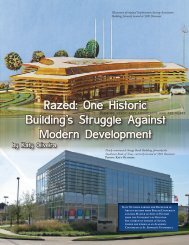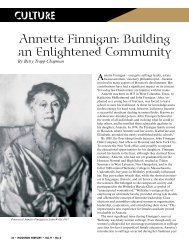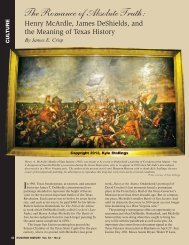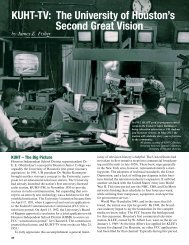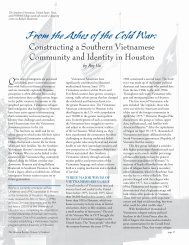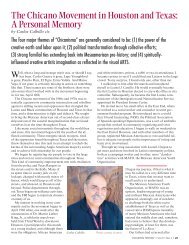preservation CAN work in houston:The Humble Oil & Refining Company Buildingby Victoria J. MyersToday, the Humble Building is home to two Marriott Hotels and the Humble Tower Apartments.Photo courtesy of Ben GiannantonioThe headlines involving historic preservation usually focuson the most visible structures. What should be done withthe Astrodome? What effect will the restoration and expansionof the Julia Ideson Building have on future preservation projects?In an earlier time in <strong>Houston</strong>, could the Shamrock Hiltonbe saved? More often, however, preservation moves forwardoutside the public spotlight. Often done by private investorswith the support of incentives from government, this work usuallyseeks to adapt sturdy, well-constructed older buildings tonew uses. The social benefits can be numerous, including lessdisruption of city life than projects that first demolish an existingbuilding and then construct a new one in its place. Moresignificantly in the long-term, preservation efforts create a citywhose tone and feel reflect an evolving community with a senseof its own past.The modern petroleum industry shaped <strong>Houston</strong>’s past, andfew companies had a greater impact on the city’s history thanthe Humble Oil &Refining Company. In 1999, Texas Monthlymagazine named Humble Oil the “Company of the Century”because it “shaped the reality and perception of Texas oil aroundthe globe.” 1 The success of Humble Oil influenced the city, thestate, and the nation, while making its leaders wealthy membersof <strong>Houston</strong>’s social elite. The construction of Humble’s originalheadquarters at 1212 Main Street was an important partof <strong>Houston</strong>’s early development. Likewise, the later efforts toremodel and preserve the building revitalized an area of downtownsuffering from urban decay. The company completedconstruction on the original building in 1921. With the additionsof Humble Tower in 1936 and another wing on the Travisside of the block in 1940, the structure served the company’sneeds until the early 1960s, when Humble Oil moved into itsnew building on Bell.Oil built the city of <strong>Houston</strong>. While Texas’ commercialoil industry began in Corsicana in 1894, the discovery of oilat Spindletop near Beaumont in 1901 established Texas, andspecifically the Gulf Coast with <strong>Houston</strong> at its hub, as a newand important center for the nation’s oil production. Of the ninefounders of Humble Oil, seven started their oil careers eitherjust before the discovery of Spindletop or soon after. Theyeach had success in the Gulf Coast with smaller oil companiesbefore pooling their resources in 1917 to form the Humble Oil& Refining Company. In 1919, Standard Oil of New Jersey (nowExxonMobil) purchased fifty percent of Humble’s stock, makingthem the largest individual shareholder of the company, andHumble an important part of the largest petroleum company inthe world. 2Reaping the financial rewards of Humble Oil, its ownersleft their mark on <strong>Houston</strong> via the company’s economic impactand their own philanthropic endeavors. One of the company’spremiere founders, Texas native Ross S. Sterling, opened afeed store close to Beaumont that supplied grain and hay forthe animals hauling supplies to a local oil field. He established46 Vol. 6, No. 3–Sports
or purchased additional feedstores and, eventually, banksnear other Gulf Coast oilfieldtowns before investing directlyin the oil industry. Around 1910,he purchased two wells nearHumble, Texas, as did otherindividual investors speculatingin the young, competitive Texasoil industry. In 1911, Sterlingand several of his fellow investorspooled their resources toestablish the Humble Oil Company,and Sterling became thecompany’s first president. 3 Sixyears later, Ross Sterling andhis brother Frank collaboratedwith seven fellow Humble-areaoil investors—Walter Fondren,Robert Blaffer, William Farish,Harry Wiess, Charles Goddard,Lobel Carlton, and Jesse Jones—to merge their six small oilcompanies into Humble Oil &Refining Company with the ninemen serving as the company’sfirst Board of Directors. 4In 1917, the Humble Oil &Refining Company purchasedthe Albert A. Van Alstyne houseat 1216 Main Street. Erected in1877, the Van Alstyne house wasthe earliest known of severalVictorian-style houses built in <strong>Houston</strong>, and one of several onMain Street. The Main Street homes gradually disappeared,however, as the growth of the city created a need for downtowncommercial property. <strong>Houston</strong>ians in the early twentiethcentury established the city’s reputation for an “out with theold, in with the new” mentality when it came to developmentopportunities. Owners of the Main Street residences began tosell the houses, and many used the profits from the sale of theirproperties to establish the new, elite, residential community ofRiver Oaks. This gave downtown room to grow on the southside. Soon after Humble Oil acquired the Van Alstyne property,the company had the house demolished to make way for thecompany’s first headquarters, the nine-story Humble Buildingon the corner of Main and Dallas. 5A New York architecture firm, Clinton & Russell, designedthe original Humble Building. Completed in 1921, the milliondollar,neo-classical structure was constructed primarily ofbrick and limestone. A few years later, Art Deco designs spreadacross the nation, and <strong>Houston</strong>’s business and civic leaders embracedthe new architectural style in a conscious effort to modernizethe look of the city. Modernistic buildings representedthe city’s future, and Art Deco architecture represented moderndesign. Some owners of neo-classical buildings, like HumbleOil & Refining, added Art Deco-inspired features to their structuresin order to look contemporary and progressive. Renovationsdone to the Humble Building in 1932 added ornamentaldetailing between the windows of the top floors, and two-story,The Humble Tower, completed in 1936, was the first city buildingconstructed with air conditioning. Architects hid the cooling tower inthe penthouse.Photo courtesy of <strong>Houston</strong> Metropolitan Research Center,<strong>Houston</strong> Public Library, <strong>Houston</strong>, Texaslimestone faux columns withan ornate finial on top. Whilenot as ornate as the 1929 GulfBuilding and other Art Decodesigns in the city, these additionsrepresented a more subtle,but still modern, approach tobuilding design of the era. 6A year after the completionof these renovations, companyofficials realized that the ninestorybuilding lacked adequateoffice space. They askedarchitects Kenneth Franzheimand John F. Staub to design anaddition to the building, andtheir collaboration producedthe seventeen-story HumbleTower, completed in 1936. 7 Intheir comprehensive history ofthe company published in 1959,Henrietta Larson and KennethPorter described the building,“with the United States flag atits mast,” as “a striking featureof the <strong>Houston</strong> skyline and asymbol to the general public ofthe company’s importance.” 8During the Humble Building’s1932 renovations, the additionof a central air-conditionerto the older building made itthe first office in <strong>Houston</strong> withthis modern amenity. The Humble Tower addition became thefirst office building in the city originally constructed with acentral air-conditioning system. Franzheim’s Humble Towerdesign cleverly hid the unit’s cooling tower with a neo-classicalpenthouse. Humble Oil’s addition of air-conditioning to itsoffice buildings set a trend for <strong>Houston</strong>’s post-World War IIdevelopment. 9 The Depression and World War II had slowed thespread of air-conditioning in <strong>Houston</strong>, but its popularity pickedup again after the 1940s. The affordability and increased useof air-conditioning encouraged businesses, and thus people, torelocate to the region, setting the stage for <strong>Houston</strong>’s post-warboom.From its modern building complex on Main Street, HumbleOil & Refining Company managed its regional operations. Inthe early 1920s, the company’s interests spread to southernOklahoma and Arkansas, western Louisiana, northern Mexico,and throughout Texas. 10 By 1960, Humble Oil’s interestsreached into Florida, Georgia, Alabama, West Texas, NewMexico and the Gulf of Mexico. 11 Forty years and two additionsafter establishing its headquarters on Main Street, Humble Oilrelocated to a new forty-four-story building several blocks tothe south on Bell in the early 1960s. In 1973, Humble Oil &Refining Company changed its name to Exxon Company U.S.A.as a part of the broader process of Standard Oil New Jersey’sconsolidation under the Exxon name. The building on Bell, nowthe Exxon Building, stands as an iconic <strong>Houston</strong> skyscraper, butwhat happened to the company’s “humble” first office? InsteadVol. 6, No. 3–Sports 47
- Page 1 and 2: Volume 6 • Number 3 • Summer 20
- Page 3: table of contentsReaders’ Forum P
- Page 6 and 7: A Conversation with...MR. ASTRO, LA
- Page 8 and 9: young player, you know, to try to m
- Page 10 and 11: Astros owners R. E. “Bob” Smith
- Page 12 and 13: all the time. And then, I spent my
- Page 14 and 15: LD: Yes, I did. Sportsman’s Park
- Page 16 and 17: By Ernesto ValdésTrying to instill
- Page 18 and 19: ecause I wasn’t very old and . .
- Page 20 and 21: Coach Tellez giving pointers to Pat
- Page 22 and 23: Rain or Shine:How HoustonDeveloped
- Page 24 and 25: since the St. Louis Cardinals owned
- Page 26 and 27: City on the international map.Peopl
- Page 28 and 29: Hofheinz worked with Monsanto to in
- Page 30 and 31: Story Sloane’s GalleryHermann Par
- Page 32 and 33: THE FIRST PROMISING RUMOUR I heard
- Page 34 and 35: Never one to hold back, an animated
- Page 36 and 37: Babe Didrikson Zaharias demonstrate
- Page 38 and 39: Babe sets up a putt at the Babe Did
- Page 40 and 41: 38 Vol. 6, No. 3-Sports
- Page 42 and 43: Today, multilingual signage of busi
- Page 44 and 45: A large crowd gathered for the much
- Page 46 and 47: The neighborhood welcome sign indic
- Page 50 and 51: of falling to the wrecking ball, as
- Page 52 and 53: SpawGlass Construction managed the
- Page 54 and 55: “KUHF’s ‘Texas Originals’ w
- Page 56 and 57: 24 Ibid; Richard Dean, “BASEBALL
- Page 58 and 59: 6 “Houston Deco: Modernistic Arch
- Page 60: University of HoustonCenter for Pub



